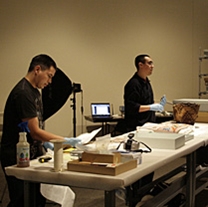Grant Spotlight | October 1, 2009
Share This |
Recipient: Tamástslikt Cultural Institute Grant: 2007 Native American/Native Hawaiian Museum Services grant Pictured: Conservation technician Ryan Ashley (right) and Randall Melton (far left) work on collection objects and explain their methods to a group of visitors. |
Contact: Web Site: |
||
(Photo courtesy of the Tamástslikt Cultural Institute.)
Located in eastern Oregon near Pendleton, the Tamástslikt Cultural Institute is a repository for the history, language, and culture of Confederated Tribes of the Umatilla Indians, which was formed in 1855 with a treaty between the federal government and three tribes now known as the Cayuse, Umatilla and Walla Walla. Tamástslikt, pronounced ‘tuh-must-lickt,’ means "to interpret or talk about something" in the Walla Walla language. More than 10,000 items are in the care of Tamástslikt, including photos, video, documents, manuscripts, books, archaeological objects, and ethnographic objects such as basketry, weaving, and regalia.
Tamástslikt accepted its first donation in 1991, and employed a full-time curator until 1998. From 1998 to 2001, Tamástslikt did not have a curator, and over the years many different staff and summer interns cared for the object collections and registration files. For these reasons, various forms of inventories, catalogues, photos, and records were created to manage the collections. Tamástslikt did not have a complete inventory of its collection, many of the object identification photos were low quality, and associated registration files were incomplete, not standardized, or centralized.
Many objects had not been handled since the late 1990s and required routine care and preventative conservation. All of the items had previously been stored in small boxes and many needed more appropriate storage environments.
In 2007, the Confederated Tribes of the Umatilla Indian Reservation were awarded a one-year, $47,086 IMLS Native American/Native Hawaiian Museum Services grant to create a comprehensive, organized, and usable catalogue of approximately 3,000 collection objects.
Organizing the Collection
"Our hope for this grant was to go through and do a systematic cataloguing and inventory project in our main collection vault, and to go through and make sure we had everything photographed with the digital camera," said Randall Melton, Collections Curator. "We switched our object labels to include barcodes so that it would be easier to access object information on our Past Perfect software."
Tamástslikt used grant funds to purchase a laptop, a barcode scanner and software, general conservation supplies, two artifact carts, an impulse sealer, a high-quality digital camera, studio lights, and backdrops.
Project activities were divided into object processing, records management, and training. During object processing, museum staff examined each object, took digital photos, and added a barcode to the object. Staff also updated catalogue and condition information, performed preventative conservation, created appropriate storage mounts, and documented each object’s storage location.
Records management entailed examining each accession or loan file to verify and update the enclosed information. Staff then placed paper copies in an acid-free folder, and relocating the folder to a centralized rotary file cabinet.
In the training phase, museum staff attended three separate training sessions on collection management and care. They learned new techniques in areas such as mount making and integrated pest management.
Tamástslikt also used grant funds to continue the employment of a full-time conservation technician and hire an additional part-time technician.
In addition, Tamástslikt created a two-month interactive conservation lab exhibit, titled "Caring for the Past: A Tamástslikt Conservation Lab," to show the public what goes on behind the scenes.
"We had an opening in our traveling exhibit calendar, so we created some panels to explain the project and our perspective on collection care, moved objects and equipment into a temporary storage area in our exhibit gallery, and continued cataloguing," said Melton.
Visitors watched as Tamástslikt staff catalogued and worked on the objects, photographed them, and updated the computer-based object catalog.
"I believe that was a real highlight of the project, to be able to show the public, both tribal and non-tribal, the level of care afforded to collection objects." said Melton.
A Successful Project
The main outcome was the creation of a nearly completed, well-organized and -documented collection catalogue. The team processed 2,367 objects and 530 registration records during the grant period.
The collection survey found that the cultural center’s objects were stable, with no evidence of progressive deterioration and very few objects displaying pest infestation. However, it became apparent that many objects needed new storage mounts. Tamástslikt staff found several instances where an oversized item had been folded and placed in a small box, which could lead to permanent creases and damage. These items were removed from their boxes and placed on large storage shelves, where they lie open with storage mounts added for support.
By showcasing real-time collections care procedures, the exhibition "Caring for the Past" allowed Tamástslikt an opportunity to help raise awareness of object care and handling. Approximately 1,110 people visited the exhibit, including three school field trip groups consisting of seven teachers or chaperones and 114 students.
The exhibition even led to the discovery of new knowledge. The exhibition prompted a tribal elder to walk through the gallery with staff and identify the maker of a buckskin dress through its beadwork application and design.
In response to the exhibit’s success, Tamástslikt is developing a traveling exhibit based on the same themes for 2010. "We’ve talked to a couple of the universities nearby us and we’ve had one that has agreed to display it," said Melton. "We’re going to get in contact with some of the other tribal museums and see if they’re willing to host the exhibit."
Lessons Learned
Tamástslikt staff gained a new understanding of the benefits of a well-organized collection. The barcode system has made it very easy to record changes in object location or status. Tamástslikt can now document relocation of an entire shelf of objects within a matter of minutes. The staff also learned new skills, such as storage mount making, specific care and handling of textiles, and object cataloging procedures.
More Access to Native Cultures
Tamástslikt completed cataloging the remaining objects during the summer of 2009, and adopted the same cataloging process for new donations coming into the collection. In addition, in 2008 Tamástslikt received a second grant from IMLS to catalogue a separate stone tool collection.
The Tamástslikt staff and community’s access to the collection has been greatly improved by the new technology. The new barcode system has simplified record changes in object location or status, allowing staff to document relocation of an entire shelf of objects within a matter of minutes.
A well-managed collection can make a difference in educational programs. One new program provided opportunities for students from a charter high school, to tour the Tamástslikt collection vault, pick out an object that they liked, read information about it, and write a report. A school project like this would not have been possible before the grant.
For Tamástslikt, the project was, "a way to show the community the level of care that things are given when they are in the museum," explained Melton. "We’ve had some donations that have come in after the exhibit that we did, because [people] were able to see us work on the collections, how the [objects] were taken care of, and the process that we followed. So that was a way to build some relationships with the community and show them that their objects will be taken care at Tamástslikt."
Staff, tribal members, and researchers can now come on site to research, view, and study thousands of objects with hundreds of associated records files. This access will ensure the tribes’ ability to retain and interpret their history, culture, and language for future generations.

